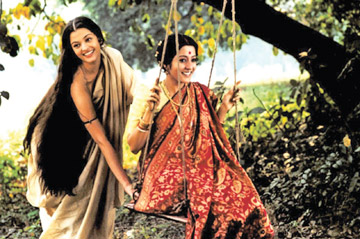|
Film Appreciation:
A sophisticated Bangla film
K S Sivakumaran
During the Tagore Film Festival (from September 1 to 5) held in
Colombo (Courtesy the Indian High Commission) five remarkable films were
shown. They were all classics in India cinema made in the Bengali
language with subtitles in English. Five feature films and one
documentary were shown. Four of the films were directed by the Master
film-maker Satyajit Ray. The other was by a sophisticated director of
recent vintage, Rituparno Ghosh. The films were all adapted from the
stories of the great Indian intellectual of the 20th century,
Rabindranath Tagore, a multifaceted artiste. A documentary on him made
by Satyajit Ray was also shown.
 |
|
A scene
from Chokher Bali |
|
Film-makers on focus
* Rituparno Ghosh
* Ritwick Ghatak
* Mirnal Sen
* Tapan Sinha
* Buddhadeb DasGupta
* Gautam Gosh
* Aparna Sen
* Utpalendra Chakkarabarthi
* Sandip Rai
* Raja Sen |
This columnist has seen all the four films of Ray several times over
during the past five decades. But it was the first time that he saw
Rituparno Ghosh’s film Chokher Bali, also based on one of Tagore’s
humanistic stories. So he wishes to talk about this film here. He has
previously seen one of Rituparno’s films at the IFFI.
So before we do that, readers might be interested to know the names
of some of the outstanding Bengali film-makers. Some film buffs might
have seen a few of these film-makers’ creations in Lanka itself. The
notable film-makers who have made international debut are Rai, Ritwick
Ghatak, Mirnal Sen, Tapan Sinha, Buddhadeb DasGupta, Gautam Gosh, Aparna
Sen, Utpalendra Chakkarabarthi, Rituparno Gosh, Sandip Rai and Raja Sen.
Usually this columnist does not like to retell the story of a film or
book, but in this instance he takes an exception in reproducing what an
Indian critic has seen the scenario in the film for better elucidation.
Here it goes:
“The book, Binodini (by Rabindranath Tagore), is the story of a young
woman, who is left to her own devices when her sickly husband dies soon
after they are married. She returns to her village and lives there for a
couple of months until she sees one of her relations passing by there on
her way to somewhere else.
Binodini hails the woman and the two soon agree that it would be best
if Binodini came to live with the woman and her son, Mahendra (who, by
the way, was one of the first to see Binodini’s photo when she was unwed
and up for grabs yet refused her on account of his being “unready for
marriage”). Now, when the two arrive the woman’s son and his new bride
are in the throes of passion, constantly sneaking off to be alone
together; this infatuation does not last long, however, when Mahendra
begins to see that his wife’s friend, Binodini, is more his type.
The story details the lives of these three and Mahendra’s best friend
as they deal with certain issues as distrust, adultery, lies, and
numerous fallings-out between them. The movie correctly depicts what
Tagore so skillfully wrote and is a sad, stirring, tale of the deceit
and sorrow that come from being unsatisfied and unhappy. Written by
gavin ([email protected]).
My comment here is both on the film’s aesthetics and the progressive
ideas on sexuality by Tagore himself. Tagore’s nationalism, his empathy
for the widows, his satirical and ironic comments on outmoded beliefs
and customs during the British India, and his damnation of superstitions
as well as upholding the fundamental values of the east re all embodied
in a nearly three-hour filmic version.
If Cinema is a director’s art here is a director who could handle an
early period piece with meticulous contemporaneous presentation thus
capturing different moods and artistic portrayal of characters. I liked
very much the playing by the four actors for their respective
expressions. In spite of her beautiful countenance Aishwarya Rai did
understand her role and gave a sustained sensitive performance as an
adulteress. The main players besides the Miss World were Raima Sen, who
is also beautiful to my eyes, Presentjit Chatterjee, Tota Roy Chowdrey
and Lily Chakravarthi were restrained performers without any dramatic
sentimentality.
The naïve and playful eroticism between Sen and Chatterjee and the
lustful sequences in which Aishwarya Ray excels are beautifully pictured
as poetic sequences in the film. The cinematography, the music and the
colour and costumes all, take us to an India that was struggling between
feudalism and modernity in age of the surging India nationalism against
Lord Curzon’s rule.
The minimal but effective dialogue and the moving images enthralled
me besides the overall artistic quality of the film.
While some outstanding films had been made in Hindi, Marati,
Asaamese, Oriya, Gujerati, Malayalam, Kannada and Tamil, the Bengali
films outshine all the rest partly due to the strong cultural milieu
that Bengal has developed for centuries.
The Indian High Commission should help us see more and more regional
films of India.
[email protected]
|



